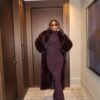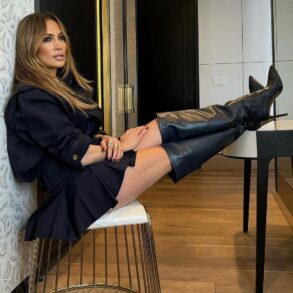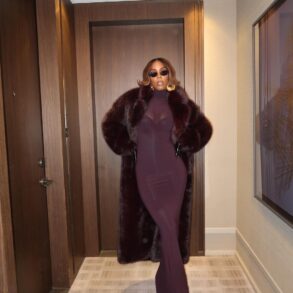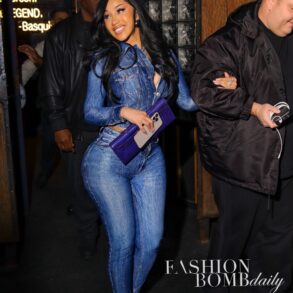NEW YORK — When Ralph Lauren looks at Ralph Lauren — the 56-year-old company and the 83-year-old man — he likes what he sees.
“The clothes are great, I must say,” he says, and a smile lights up his face, which remains mischievous and perfectly tanned. “It’s fun for everybody,” he says of the company (he hates the word “brand,” he says. “There’s a heart to this company”). “No matter what their taste is. They want to express themselves. They want to feel cool. They want to be young. It represents energy and life.”
“I don’t know if everyone loves me,” he adds. “They should love me.”
Until last week, Lauren hadn’t shown a collection in New York since March of 2022. His Friday show was the marquee event of New York Fashion Week, engineered to jazz up a fashion calendar that the American fashion industry says lacks star power. Lauren staged the show in a Brooklyn Navy Yard warehouse twice — once at 5 p.m. and again at 7 p.m. — with the second show followed by a dinner for 250 celebrities and editors.
He showed couture-ified denim looks, paisley jewel-tone tailoring, a fantastic halter gown in madras silk — plus supermodels Natalia Vodianova in a golden fringe caftan and Christy Turlington in a gold lamé one-shoulder gown — to an audience rarely assembled outside of award season. Jennifer Lopez giggled with Diane Keaton. Amanda Seyfried and Ariana Debose texted each other from across the room. Amid the Hollywood strike, when celebrities are practically in hiding, it was a major flex. Julianne Moore, Gabrielle Union, Sofia Richie, Keri Russell, Robin Wright and Lauren Dern were all in attendance.
When the show ended, Lauren came out in his New Balances and gestured behind him. A pair of barn doors flung open, and suddenly — like some kind of mirage! — there was a sprawling room of candlelit tables, and handsome waiters with trays of champagne and margaritas with little croquet mallets for cocktail stirrers. Lobster salad appeared — big chunks of claw meat, too, none of that shredded stuff — and then hundreds of steaks, all magically medium-rare, placed before guests by another group of handsome waiters. And french fries! Piping hot! In little silver trophy cups, and a little silver pail filled with ketchup! Everything in Lauren’s world lives up to your rose-colored memories of fancy restaurants or outfits or people you’ve seen in the movies — or maybe it’s even better.
How does he pull off extravagant shows like this? “I think we’ve been lucky that things work out so nicely,” he says. “Not everything is perfect. You know, I’ve had some losers. But not many.” He pauses. “Sounds like Sinatra.” He starts singing: “Regrets — gotta few!”
Most of the fashion greats, who invented the businesses we know today, are dead or retired: Karl Lagerfeld, Yves Saint Laurent, Gianni Versace, Virgil Abloh, Calvin Klein. The last men standing are Lauren and 89-year-old Giorgio Armani. Lauren is a bona fide celebrity, more so than even Lagerfeld was. People ask for his autograph on the street; “very Ralph Lauren” is shorthand for elegance, class, sophistication that’s somehow specifically American.
Graydon Carter, the Air Mail founder and editor and former Vanity Fair chieftain, whose wife Anna once worked for Lauren and who counts the designer and his wife as friends, says that along with Disney, Apple, Nike and Coca-Cola, “The Ralph Lauren brand is probably the most famous American brand outside the United States — that’s something.”
Lauren started his company in 1967 with just one product: a fat tie. It looked outrageous — this was the era of narrow suits and polyester fabrics — but when Bloomingdale’s finally bought it, it swiftly sold out. From there, he made a few shirts, then some tailoring, and in the early 1970s started making womenswear. He designed costumes for “The Great Gatsby” and dressed Diane Keaton in “Annie Hall” — in both films, developing styles that are widely copied to this day.
By 1996, he was a billionaire and took the company public the following year. More recently, he stepped down as CEO and is now executive chairman and chief creative officer.
The first few years after this reorganization were rocky, but since 2017 the company has found balance under a new chief executive, Patrice Louvet. Revenue has climbed steadily over the past two years. Lauren’s empire has expanded to include New York’s Polo Bar, which in a city known for impossible-to-get reservations, is genuinely impossible to get, and Ralph’s Coffee, which has turned uptight 72nd and Madison Avenue into a hot spot. (Fans have even designed entire bat mitzvah parties in homage to the cursive font and Kelly-green design scheme.)
Did he start off with that tie knowing it would lead to all this? “I never planned that I’d be anything more than what I was doing at the moment,” he says. “It just came. All of a sudden I have a restaurant. All of a sudden I have the hottest coffee shop in the world.”
More than any other designer, living or dead, Lauren is synonymous with American fashion. The Bidens look to him frequently; for President Biden’s suits; for Jill Biden’s sky-blue suit and hat for King Charles III’s coronation; for granddaughter Naomi Biden’s wedding dress. When Donald Trump was inaugurated as president, Melania Trump and Hillary Clinton wore Ralph Lauren. (One of his sons, David, who also works at the business, is married to former president George H.W. Bush’s granddaughter Lauren.)
Lauren’s longevity is unusual. Perry Ellis, Donna Karan, Calvin Klein — none have their eponymous designer, and all have faded from influence. Why has Ralph Lauren survived, with its founder still at the creative helm?
“Talent,” he says simply. “I survived because I fought for what I wanted and what I believe in.”
Not everyone accepted him in the beginning; he recalls a fashion critic mocking his wearing a tuxedo jacket with blue jeans and cowboy boots to a black-tie event. “I earned my own individuality. Sometimes they didn’t get it. Many times they didn’t get it. And I just kept going forward.”
“At a certain point, survival is a great attribute,” says Carter. “And he’s done more than that.”
For a long time, Ralph Lauren stood for elitism, Whiteness, preppiness — an idea Lauren loathes: “No matter what I say, it’s preppy.” His biography is a version of the American Dream that seems increasingly impossible: born Ralph Lifshitz to immigrant parents who worked as an artist (his mother) and house painter (his father) in the Bronx, he is now worth nearly $7 billion. I ask him whether he’d still change his name if he were starting his company today. “It was a tough name when I was a kid,” he says. People made fun. “It had the word ‘s—’ in it.” It was a different time, he acknowledges. “Today, I don’t know if I would do it or not.”
Younger designers and shoppers grew up learning about Lauren through his golden age of 1990s ads, hearing his name dropped in rap songs and seeing his clothes romanticized by the Lo Lifes, young men from Crown Heights and Brownsville who wore (and shoplifted) Ralph Lauren obsessively, and laid the groundwork for hip-hop’s entwinement with high fashion. To them, Lauren pioneered a process of endlessly remixing the anthology of American clothing, styles and aspirations, an idea that’s evident today with big skate brands such as Supreme to new labels such as 45-year-old Jerry Lorenzo’s Fear of God and Emily Bode Aujla’s Bode. American fashion is really much more about style than fashion itself — self-expression, reinvention and identity exploration, more than originality and fantasy — and Lauren built the first business where those two things convene. (As Carter put it, “He told the story of America back to America. He’s like a human mural.”)
Today, fewer designers dictate trends or seek out newness. Instead, most are evolving their process to look at their own lexicon of styles and influences and reinterpret them each season. You can see that everywhere from Willy Chavarria, the 56-year-old designer whose runways are homages to the clothes of his Chicano upbringing, to 37-year-old Teddy Santis’s Aimé Leon Dore, where in the Nolita store preppy clothes are on display to a soundtrack of hip-hop.
In fact, nearly every emerging designer in New York name-checks Ralph Lauren as the designer they want to be and the business they want to build. (And both Bode Aujla and Santis’s downtown stores have coffee shops!)
Perhaps his biggest impact has been on Bode, widely considered to be the next great American legacy brand. Bode Aujla, 33, interned at Ralph Lauren in college, an experience that she says “had a profound effect on me. I was able to see how the brand vision was so intricately aligned within every facet of the company — from trim design to the vintage archives to showroom display to retail training.” You can see how she’s followed the Lauren playbook, starting with one great and very unusual product — a jacket made from antique textiles and fabrics inspired by antique textiles — and then building out a whole aesthetic universe that’s become recognizable even outside of her own clothes. She learned her auteur approach from Lauren, saying that she saw how “considering every detail within a brand proves to strengthen the creative power of that brand.”
It is true that everything Lauren’s eye might grace is Lauren-ified. Even the security person who locks up at night has a Ralph Lauren style, wearing a crisp blue sweatshirt and a baseball cap that’s worn in just the right, comfy way. Visitors to his homes in Bedford in New York, Jamaica, Montauk and Telluride, Colo., report that he provides a wardrobe inspired by the location upon arrival.
Maybe the reason this has worked so well for so long is that Lauren lives it. Other designers come out at the end of a show, after having sent 50-some fantastical looks down the runway, in a black T-shirt and pants. Lauren comes out in cargo pants, a safari shirt and New Balances. (When he asked his wife about the look earlier in the day, he says, she said, “‘No, no, no. I don’t like that.’ I said, ‘Why are you telling me this?! Look where I am! You’re okay, Ralph!”)
When we speak, he’s wearing a blue striped T-shirt, tight jeans, a faded denim jacket with a little heart patch and a Western belt. (All his design, of course.)
How does he describe his style? “Free. I could be very conservative — I wear pinstripe suits, I wear ties. [But] I don’t have the goal to be the denim king or the safari king.” He dresses for the place he is. “I always love living different lives in different places. “I know what I’d wear if I’m in Colorado. I know what I wear upstate. I reflect on my own sense of what I would love to have, and I do it.”
Mostly what motivates Lauren is fun. The reading room outside his office is classic Ralph Lauren, comfortably imperious — wood-paneled, leather sofas, big plushy pillows — but his office is brimming with toys and antiques and objects and mementos: old planes, teddy bears in tuxedos, children’s moccasins, a Barbie doll in blue jeans, another in a tux. A six-foot-tall tennis racket (“I like things that are really big or really tiny.”) A letter from Henry Kissinger laying over a handwritten letter from Lagerfeld. There are old penny loafers, a robot with two lightbulbs as antenna, a two-foot-tall stack of blue and pink and yellow boxes, tied with silk ribbons. Endless pictures of his wife of nearly 60 years, Ricky, and their three children, in gleaming silver frames; a side table covered in action figures from comic books.
That mixture of stuff — joyful, a bit chaotic, unexpected, witty, antique — that’s the Ralph Lauren DNA.
The fashion world wonders about what will happen after Lauren is no longer here. Does he want to do this forever? “I’ve done it forever!” What will happen after he’s no longer there? “I don’t want what I created in 1967 to be old or what I create 56 years from now to be new,” he says. “I believe in clothes and things that never go out of style because they are not trendy, but timeless. I’ve always believed in style, not fashion, and things that get better with age. I hope 56 years from now there will be women that grew up in my clothes still wearing them.”
But there are so many things to play with in the Lauren world — and so many designers who know how to do it — that it is exciting to think about the future of Ralph Lauren. The designer feels the same. “One of the challenges is [asking myself], ‘What’s new, Ralph?’” He smiles. “I think the world is getting better. Not on every level but on the level of taste in America, which is what I do,” he says. “There’s more integrity, there’s more luxury. The world has got problems, but this” — the world of Ralph Lauren, which through Ralph’s eyes, is nearly everything beautiful and good — “is happy, in a world that’s not happy.”








